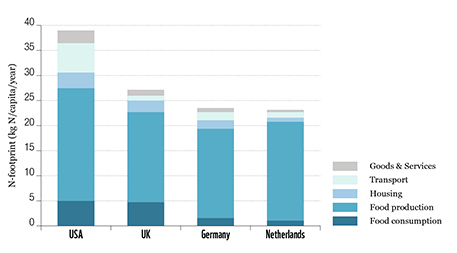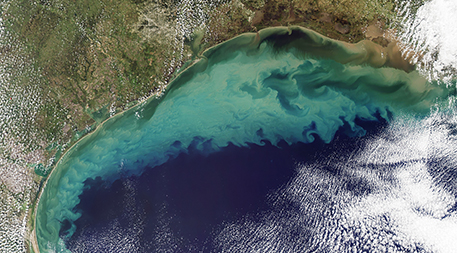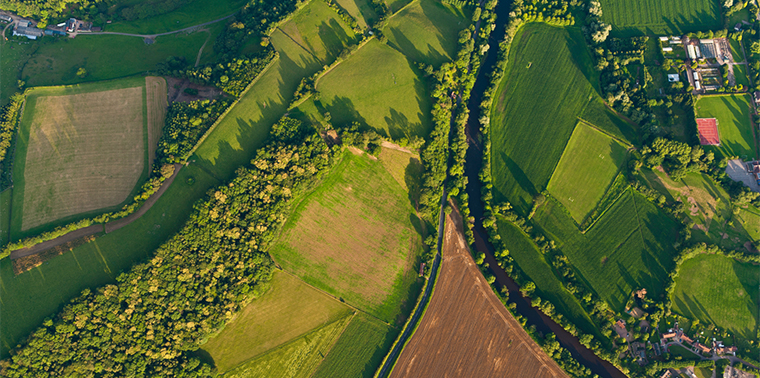March 25, 2016 — Coastal dead zones, global warming, excess algae blooms, acid rain, ocean acidification, smog, impaired drinking water quality, an expanding ozone hole and biodiversity loss. Seemingly diverse problems, but a common thread connects them: human disruption of how a single chemical element, nitrogen, interacts with the environment.
Nitrogen is absolutely crucial to life — an indispensable ingredient of DNA, proteins and essentially all living tissue — yet it also can choke the life out of aquatic ecosystems, destroy trees and sicken people when it shows up in excess at the wrong place, at the wrong time, in the wrong form. And over the past century, people have released so much of this type of nitrogen — known as reactive nitrogen — that scientists say we’ve passed the limit of what the planet can safely handle.
The result of releasing so much nitrogen to the environment — through excessive and inefficient fertilizer use, agriculture-related nitrogen emissions and nutrient-laden wastewater, along with fossil fuel and biomass burning — is this slew of adverse environmental impacts. These impacts are occurring worldwide and are exacerbated by warming temperatures. Though the nitrogen problem gets far less press, we’ve now upset the naturally occurring balance of nitrogen even more than that of carbon.
While many things contribute to the problem — including energy use, urban runoff and sewage — agriculture is the largest source of environmentally damaging nitrogen. According to scientists studying this problem, approximately 80 percent of the nitrogen currently used in agriculture (primarily synthetic and other fertilizers, like manure) is lost to the environment at some point in the food supply chain. These losses occur on farms and in food production, sales, distribution, preparation and consumption. Or, as University of Virginia professor of environmental sciences Jim Galloway puts it, losses occur “all along the way from the field and bare soil to the sewage plant.”
A big part of the problem, according to Jan Willem Erisman, University of Amsterdam professor of integrated nitrogen studies and CEO of the Louis Bolk Institute in the Netherlands, is that “people don’t connect it to food and food production.” In fact, in the U.S., European Union, Japan and likely China and elsewhere, food accounts for more than 75 percent of the average person’s nitrogen footprint (individual contribution to nitrogen pollution), according to University of New Hampshire natural resources and environmental studies Ph.D. candidate Allison Leach, who is among the scientists working on the Nitrogen Footprint, a project designed to raise awareness of the issue. And it turns out that meat and other top-of-the-food-chain animal products — those that consume the most resources before they themselves become food — are among the biggest culprits in contributing to excess nitrogen in a form that can be damaging to the environment.
What happens on a farm field can show up as algae many miles downstream.
Such nitrogen pollution has contributed to harmful algae blooms plaguing Chesapeake Bay, the Great Lakes and the Gulf of Mexico; 2014’s drinking water crisis in Toledo; and “blue baby syndrome,” a potentially fatal oxygen depletion disorder that harms infants around the world — among other effects. Part of the difficulty in making people aware of these connections is that they often show up as “disruptions in distant places,” Erisman explains. What happens on a farm field can show up as algae many miles downstream and offshore, for example, or show up in groundwater that supplies well water to residents without direct connections to the source of contamination. Connecting water pollution or air pollution with food choices is even more of a stretch.
But before unraveling why a cheeseburger will expand your nitrogen footprint more than rice and beans, it helps to understand how we got to where we are now — with excess nitrogen creating dangerous river-choking algae blooms, fish-killing dead zones, unsafe drinking water and unhealthy levels of smog in cities worldwide — and how nitrogen works in the environment.
First, it’s important to know that the type of nitrogen that makes up a large part of the Earth’s atmosphere is not reactive but inert. For that nitrogen to be used by plants and other organisms, it must be converted into what’s called a “fixed,” or reactive, form. The main way this happens in nature is through microbes that live in soil and plant roots and convert inert nitrogen to ammonia, a reactive form that can be used in — and is essential to — plant growth. While plants need this reactive nitrogen to thrive, if excessive amounts enter the environment, they contribute to a suite of adverse effects. And ammonia is not the only form of reactive nitrogen; others — nitrous oxide, nitrogen oxides, nitrate and nitrite — can also become serious air and water contaminants and prompt respiratory, cardiovascular and other diseases. Key to understanding this problem — and its solutions — is that this overload didn’t happen on its own.
Without human intervention of some sort, the world’s naturally occurring supply of reactive nitrogen essential to plant growth is relatively limited. So by the beginning of the 20th century it became apparent that there wasn’t going to be enough of this form of nitrogen available to produce the volume of food needed to adequately feed a growing population. This problem was solved by the invention of synthetic fertilizers that supply plants with nitrogen in a “fixed” form they can use. Agricultural productivity soared. But the use of these fertilizers has not been very efficient, resulting in the release of large amounts of reactive nitrogen into the environment. According to Galloway, Leach and colleagues, so much anthropogenic reactive nitrogen has been produced that by 2010, human activity was creating at least five times as much as were natural systems.
Stocking the fridge with meat plays a big role in contributing to the global reactive nitrogen burden.
These releases, scientists have discovered, can last for decades. Not only is the nitrous oxide that comes off fertilized fields a potent greenhouse gas, but a new study of fertilizer use in the U.S. Midwest shows that excess nitrogen can accumulate in soil and result in decades-long pollution of surface and groundwater — including drinking water wells — with unsafe levels of nitrates that can lead, for example, to blue-baby syndrome. Even if fertilizer use were stopped today, the nitrogen pollution would persist for years, writes study co-author Nandita Basu, University of Waterloo professor of earth and environmental sciences and civil and environmental engineering.
Meanwhile, as agricultural productivity soared in the early 20th century, ever-greater quantities of fossil fuels were being burned, releasing yet more reactive nitrogen into the atmosphere. Urbanization and growing populations have also added to this burden, but about three-quarters of this reactive nitrogen comes from agriculture. And given increasing demand for meat and dairy, an enormous amount of what we now grow — from about one-third of the world’s arable land, according to the Food and Agriculture Organization of the United Nations — ends up as livestock feed.
Meat’s Big Nitrogen Footprint
“The choice of meat or plant is very important,” says Erisman. “Plants’ nutrient-use efficiency is much higher than that of meat.” Plus, to produce meat you must first grow grain or other forage — whatever plant products the animals eat. As a result, many more times the amount of nitrogen is involved in producing meat than plant-based food. This means that stocking the fridge with meat plays a big role in contributing to the global reactive nitrogen burden.

Average personal nitrogen footprints in the United States are larger than those in the United Kingdom, Germany and the Netherlands because of higher per capita meat consumption and transportation energy use, lower fuel efficiency, and less-advanced sewage treatment. Image courtesy of WWF
“We’re growing meat,” says Tom Fisher, professor at the University of Maryland’s Center for Environmental Science’s Horn Point Laboratory. “Much of the agriculture on the Delmarva Peninsula, where I am, is growing grain for the poultry industry. … People have chosen to eat meat, and they’ve created a market for chickens, and the poultry industry created a market for grain.”
And it takes even more feed to produce beef and pork than it does chicken. The exact numbers vary depending on how resource use is estimated, but according to Erisman and other researchers it typically takes 6 kilograms (about 13 pounds) of reactive nitrogen to produce 1 kilogram (about 2 pounds) of beef, about 3 kilograms (almost 7 pounds) for 1 kilogram of pork and about 2.5 kilograms (5.5 pounds) of nitrogen for 1 kilogram of chicken. Erisman also points out that, due to lopsided food choices, about 20 percent of the world’s population consumes about 80 percent of the fertilizer.
“When it comes to food choices, frequency and portion size of animal foods and the mix of animal products can have a big effect on the end [nitrogen] footprint,” says Eric Davidson, professor and director of the Appalachian Laboratory at University of Maryland’s Center for Environmental Science.
A look at the N-Print project’s Nitrogen Footprint Calculator illustrates this well. According to its figures, the average U.S. nitrogen footprint for food — an estimate of all of the nitrogen involved in this food’s life cycle, production through consumption — is 61 pounds (28 kilograms) per year. A vegetarian who eats only two eggs a week and limits dairy products — including cheese — to no more than 15 one-cup servings a week reduces that load to 24 pounds (11 kilograms). For non-vegetarians, if meat consumption is limited to eating only poultry (no beef or pork) four times a week (based on 7-ounce [200-gram] servings), the nitrogen footprint would decrease by about one-third even with no other changes to “average” U.S. eating patterns (eating five eggs and 26 servings of dairy and cheese a week).
“The single largest source [of nitrogen pollution] is from cropland.” –Adam Chambers
While raising livestock and poultry has a particularly large nitrogen footprint, another load comes when food is processed. “There’s a lot of waste in the food processing step,” Erisman explains, and food wasted means nitrogen lost because that food is not being consumed. Still more nitrogen is ultimately lost to the environment through food waste in retail and by consumers. Given that about one-third of the food produced globally each year is wasted or lost, this is significant since replacing that food means using and releasing still more reactive nitrogen. One recent estimate puts the amount of nitrogen lost to the environment because of global consumer food waste at 2.7 million metric tons (2.9 million tons) per year.
So along with increasing nitrogen-use efficiency in farming, reducing fossil fuel use and curbing urban runoff, changing food choices and reducing food waste can contribute significantly to reducing the global reactive nitrogen burden.
Leaving the Farm
Still, “the single largest source [of nitrogen pollution] is from cropland,” says Adam Chambers, leader of energy and environmental markets with the U.S. Department of Agriculture’s Natural Resources Conservation Service. When synthetic fertilizer or manure is applied to agricultural soil but not fully taken up by plants it will enter the environment, either by volatilizing or washing off fields, he explains: When it evaporates, this nitrogen typically enters the atmosphere as nitrous oxide, a potent greenhouse gas; when more fertilizer is applied than plants can use, excess nitrogen runs off with rain and irrigation water.
Certain farming practices and methods exacerbate this runoff, says Valerie Dantoin, who teaches sustainable agriculture at Northeast Wisconsin Technical College and with her husband, Rick Adamski, runs an organic dairy farm. When fields get too heavily tilled, soil microbes that fix nitrogen are destroyed, she explains. “The solution is perennial roots and leaves in cover crops” along with building up soil’s organic matter, she says, which “encourages the microbial life of the soil.” This results in slow releases of nitrogen to plants, which is more effective and efficient than synthetic fertilizers that can be easily washed away.
Efficient nitrogen use — key to what’s sometimes called “precision agriculture” — reduces nitrous oxide emissions, Chambers says, and also runoff to streams and ultimately to places like Chesapeake Bay, the Great Lakes and the Gulf of Mexico. Timing of fertilizer application is also key to reducing runoff. Rainstorms play a big role in this, Chambers explains. If it “rains 2 inches [5 centimeters] one night and plants weren’t ready to take up the nitrogen, you can get a huge spike in emissions.” Even two such events in a year can make a difference, prompting big runoffs of nitrogen — some of which also evaporates, he says.

Nitrogen pollution is partly to blame for harmful algae blooms plaguing the Gulf of Mexico and other places that can create coastal dead zones. Image courtesy of Jeff Schmaltz, MODIS Rapid Response Team at NASA GSFC
“In our region, 70 percent of our agricultural runoff occurs in 17 days of the year,” Dantoin says — during big spring rains, which typically happen at the time of year just before or just after the annual crop has been planted, when plants are not yet up and making full use of the nitrogen. The rains also come in the fall, when crops are no longer using nitrogen. To correct the problem, she says, “all we have to do is fix those 17 days.” This would mean applying fertilizer at the precise time plants can make the best use of it and — to avoid excess lingering in the soil to be washed off with those big rains — not applying any more than plants can use.
Some farmers, like Dantoin and those Fisher is working with in Maryland as part of a watershed-scale experiment to reduce nutrient runoff to Chesapeake Bay, are planting cover crops and setting up drainage systems that absorb water rather than let it careen off the land. Others are using products designed to help plants absorb nitrogen fertilizers more efficiently.
These include products that work with fertilizer in ways that stabilize or inhibit loss of nitrogen to the environment, explains Greg Schwab, director of agronomy at Koch Agronomic Services, one company in this market. “It helps farmers use fertilizer more efficiently,” he says — efficiency that can ultimately improve crop yield. Using fertilizer effectively and applying just the right amount at the right time is key, say Davidson and others, because such practices eliminate financially and environmentally costly waste and help crops.
There are now so many such nitrogen-efficiency products on the market that the Environmental Defense Fund has launched a program called NutrientStar to help farmers compare nitrogen management tools. Choosing correctly is important because “nitrogen is hard to manage,” says Steve Sibulkin, CEO of a company called Agronomic Technology Corp that makes a nitrogen data management tool, Adapt-N. “Lots of things affect how nitrogen behaves: crops, soil type, weather,” he says, so what works for one farm — or even a particular field on a single farm — might not work well elsewhere.
Large-scale Nitrogen Reduction — Still In the Works
While there are enforceable limits on many nitrogen-based pollutants in the U.S. — including under the Clean Air Act and Clean Water Act — efforts to decrease nitrogen releases do not currently include specific targets for comprehensive reductions.
U.S. and European efforts to reduce nitrous oxide emissions from fossil fuel burning, however, have been remarkably effective. These measures include regulations requiring technology to reduce industrial smokestack emissions and clean-burning engines. They also include government and company policies on greenhouse gas emission reductions — some mandatory, some voluntary — that also reduce harmful nitrogen releases. And with the growing recognition of agriculture’s contribution to nitrogen-based air pollutants, policies are beginning to focus on these as well, but specific measures in the U.S. vary depending on farm size and location.
Policies in the Netherlands and Denmark that have effectively pushed farmers to implement measures that reduce emissions from manure — through agricultural waste containment and fertilizer application techniques — have succeeded in reducing ammonia releases by 70 percent in the Netherlands and 40 percent in Denmark, helping to significantly reduce overall reactive nitrogen releases. While there is nothing comparable in the U.S., the U.S. Department of Agriculture and Environmental Protection Agency — and some individual states, including California — have programs to help states and farmers reduce nitrogen emissions and runoff. But right now, these efforts don’t yet take what might be described as a holistic approach to nitrogen releases throughout agriculture and food production.
“Denmark and the Netherlands are way ahead of the others in taking measures on nitrogen,” says Erisman, but Germany, Austria, France and Italy are beginning to follow this example. Public perception of the problem, he says, is still very low, though.
“We need solutions on both ends” — at the farm scale but also on the consumer end — says Leach. “It’s so critically important to talk to all the stakeholders in this, not just the producers but also the consumers,” says Galloway. But one way or another, the problem “is caused by humans, by the growing of food and disposal of waste,” says Fisher. Raising awareness of this issue is an important step in getting a grip on nitrogen footprints. Something to think about, perhaps, next time you contemplate a veggie versus a beef burger. ![]()
Update 5.18.16: The piece was updated to correct errors introduced in late-stage editing. It now states that nitrogen pollution “contributed to” rather than “is responsible for” various harmful algae blooms and the Toledo drinking water crisis, and dates the Toledo crisis to 2014.
Ensia shares solutions-focused stories free of charge through our online magazine and partner media. That means audiences around the world have ready access to stories that can — and do — help them shape a better future. If you value our work, please show your support today.
Yes, I'll support Ensia!

Nutrient loading also impacts coastal wetlands. Wetlands loss in coastal Louisiana over the past two decades has been concentrated around the outflow of major river diversion projects.
1. The lack of nitrogenous (urine and protein) waste treatment in municipal sewage, due to a faulty test, nobody wants to admit, but also is a nutrient pollution. Wp.me/p5COh2-2C
2. The fact that septic tank do not treat sewage, only solubilize waste so it can get into groundwater
3. The impact of 'green'rain' or rain containing reactive nitrogen (fertilizer), the result of the burning of fossil fuels, the increased use if synthesized fertilizer and increased frequency of lightning storms, the result of global climate change.
When this rain falls on land it stimulates the growth of grasses and brush, that become the kindle wood for the hard to control range and wildfires, during the dry season and when it, either falls directly or indirectly, via runoffs, in water, it stimulates algal growth.
The public, especially the farming communities, should demand that without first acknowledging and quantifying these major nutrient sources, any new regulation should be halted and existing lawsuits dismissed.
Still, I can't help but be extremely frustrated by the idea that all meat eating leads to the lion's share of nitrification.
The interminable vegan/vegetarian drum beat.
It is exactly like blaming the lion's share carbon emissions on automobiles and not the production of electricity.
Why is this?
Is this because it easier to see oneself hopping on a bus but heaven forefend reducing one's energy consumption?
Is it easier to imagine giving up meat but for god sakes I will die before I think of an alternative to a toilet?
Think about it. If we put our energy into the entire nitrogen cycle, the fact that we're bound to the whole petrochemical industry as our source, and as our source of destruction, what better way to end that than by reimagining our waste water cycle. That cycle which I am sure is responsible for a greater portion of nitrification that meat production.
If we recycled and managed the nitrogen waste in waste water systems we could kill two buzzards with one stone.
Don't get me wrong, I loathe what Ed Abbey referred to as "ugly, clumsy, stupid, bawling, stinking, fly-covered, shit-smeared, disease-spreading brutes. They are a pest and a plague." As well as the rest of the over industrialised agricultural industry as a whole.
But when an article goes for so long discussing one source of emissions, whilst avoiding other very real and greater sources, the author can be accused of concentrating on the peas and not the steak.
(33 U.S.C. 1251 et seq.)
AN ACT To provide for water pollution control activities in the Public Health Service
of the Federal Security Agency and in the Federal Works Agency, and for
other purposes.
Be it enacted by the Senate and House of Representatives of the
United States of America in Congress assembled,
TITLE I—RESEARCH AND RELATED PROGRAMS
DECLARATION OF GOALS AND POLICY
SEC. 101. (a) The objective of this Act is to restore and maintain
the chemical, physical, and biological integrity of the Nation’s
waters. In order to achieve this objective it is hereby declared that,
consistent with the provisions of this Act—
(1) it is the national goal that the discharge of pollutants
into the navigable waters be ELIMINATED by 1985."
So, permitting was to have ceased in 1985 and strict ENFORCEMENT of a water pollution moratorium should be being Exclusively PERPETUATED.
Let's do this:
1. stop feeding livestock grain!
2. Stop growing monocrops that destroy the topsoil and create the nitrogen problem
3. Stop using synthetic fertilizer
4. Start thinking about how to do agriculture better... Look at www.polyfacefarm.com and others.
There is a better and sustainable and even regenerative way to grow all the foods we need (including meat) without destroying the earth like all the corn and soy crops are now doing.
As a farmer, I am both a policy-taker and price-taker - and it is these signals that provides the agriculture community direction. It does seem convenient and efficient to pass more policies to address this obvious problem, but again, we have moved beyond our normal solutions.
Our watershed and landscape issues are now issues of governance - http://bit.ly/1MskTzc
On the reference in the comments to Polyface Farm: it buys feed grown elsewhere as well. Things are not what they may seem.
Another great article on this topic:
http://www.slate.com/articles/health_and_science/the_efficient_planet/2013/03/nitrogen_fixation_anniversary_modern_agriculture_needs_to_use_fertilizer.html
its a very good topic to rise awareness among farmers.